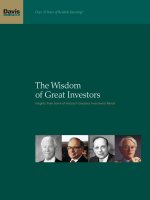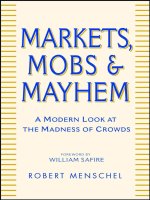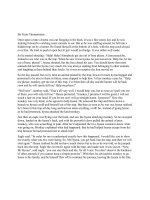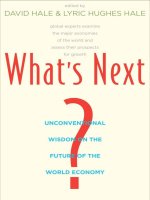The wisdom of crowds
Bạn đang xem bản rút gọn của tài liệu. Xem và tải ngay bản đầy đủ của tài liệu tại đây (9.98 MB, 336 trang )
A NEW YORK TIMES BUSINESS BESTSELLER
"As entertaining and thought-provoking as The Tipping Point by
Malcolm Gladwell. . . . The Wisdom
of
Crowds ranges far and wide."
—Tlte Boston Glohe
THE WISDOM
OF CROWDS
JAMES
SUROWIECKI
WITH A NEW AFTERWORD BY THE AUTHOR
Sociology/Economics
A
BUSINESSWEEK
AFORBES.COM
BESTSELLER AND BEST
BOOK OF THE YEAR
BEST BOOK OF THE YEAR
"A fun, intriguing read—and a concept with
enormous potential for CEOs and politicos
alike." —NEWSWEEK
I
n this fascinating book,
New Yorker
business
columnist James Surowiecki explores a decep-
tively simple idea: Large groups
of
people are
smarter than an elite
few,
no matter how brilliant—
better at solving problems, fostering innovation,
coming to wise decisions, even predicting the future.
With boundless erudition and in delightfully
clear prose, Surowiecki ranges across fields as diverse as popular culture,
psychology, ant biology, behavioral economics, artificial intelligence, mili-
tary history, and politics to show how this simple idea
offers
important
lessons
for
how we live our lives, select our leaders, run our companies,
and think about our world.
"This book is not just revolutionary but essential reading for everyone."
—THE CHRISTIAN SCIENCE MONITOR
"Provocative. . . . Musters ample proof that the
payoff from
heeding
collective intelligence is greater than many
of
us imagine."
—BUSINESSWEEK
"There's no danger
of
dumbing down for the masses who read this
singular book."
—ENTERTAINMENT
WEEKLY
Cover photograph © Leo Mason/Getty Images
Author photograph © David Surowiecki
Cover design by John Gail
www.anchorbooks.com
U.S. $14.95 CAN. $19.95
ISBN 978-0-385-72170-7
9 780385 721707
for
James Surowiecki's
THE WISDOM OF CROWDS
"Clearly and persuasively written." • :
r
: —Newsday
"Convincingly argues that under the right circumstances, it's the
crowd that's wiser than even society's smartest individuals. New
Yorker
business columnist Surowiecki enlivens his argument with
dozens
of
illuminating anecdotes and case studies from business,
social psychology, sports and everyday life."
—Entertainment Weekly
"Dazzling. . . . One
of
those books that will turn your world upside
down. It's an adventure story, a manifesto, and the most brilliant
book on business, society, and everyday
life
that I've read in years."
—Malcolm Gladwell, author
of The Tipping Point
"Surowiecki's clear writing and well-chosen examples render com-
plicated mathematical and sociological theories easy to grasp. . . .
[His] accounts
of
how the wisdom
of
crowds has formed the world
we live in will thrill trivia mavens—and may make a better investor
(or football coach) out of anyone who takes its conclusions to
heart." —Time Out
New York
"This book should be in every thinking businessperson's library.
Without exception."
—Po Bronson, author
of What Should I Do
with
My Life?
"Drawing from biology, behavioral economics, and computer sci-
ence, Surowiecki offers answers to such timeless—and often
rhetorical—questions as "Why does the line you're standing in al-
ways seem to move the slowest?" and "Why is there so much
garbage on TV?" The result is a highly original set
of
conclusions
about how our world works."
—Seed,
magazine
1
>
:
• ,
•"'
- if
. <
. • r
"As readers
of
Surowiecki's writing in
The New Yorker
will know, he
has a rare
gift for
combining rigorous thought with entertaining ex-
ample.
[The Wisdom of Crowds]
is packed with amusing ideas that
leave the reader feeling better-educated."
—Financial Times
(London)
"The book is deeply researched and well-written, and the result is
a fascinating read." —Deseret
Morning News
"Jim Surowiecki has done the near impossible. He's taken what in
other hands would be a dense and
difficult
subject and given us a
book that is engaging, surprising, and utterly persuasive.
The Wis-
dom of Crowds
will change the way you think about markets, eco-
nomics, and a large swatch
of
everyday life."
—Joe Nocera, editorial director
of Fortune
magazine
and author
of
A
Piece of the Action
"Makes a compelling case." , —The
Gazette
(Montreal)
"Deftly
compressing a small library's worth
of
research into a single
slim and readable volume, 'The Financial Page' columnist at
The
New Yorker
makes his bid to capture the Zeitgeist as his colleague
Malcolm Gladwell did with
The Tipping Point.
. .
.
The author has
produced something surprising and new: a sociological tract as
gripping as a good novel." —Best
Life
"Surowiecki is a patient and vivid writer with a knack
for
telling ex-
amples." —The Denver
Post
"Most crowds
of
readers would agree that Jim Surowiecki is one of
the most interesting journalists working
today.
Now he has written
a book that will exceed even their expectations. Anyone open to re-
thinking their most basic assumptions—people who enjoyed
The
Tipping Point,
say—will love this book."
—Michael Lewis, author
of Moneyhall
"The author has a knack for translating the most algebraic
of
re-
search papers into bright expository prose."
—The New York Times Book Review
"Surowiecki's is a big-idea book." —Salon
"It has become increasingly recognized that the average opinions
of groups is frequently more accurate than most individuals in
the group. The author has written a most interesting survey
of
the
many studies in this area and discussed the limits as well as the
achievements
of
self-organization."
—Kenneth
Arrow,
winner
of
the Nobel Prize in Economics and
Professor
of
Economics (Emeritus), Stanford University
"An illuminating book."
—Detroit
Free Press
THE WISDOM OF CROWDS
James Surowiecki is a
staff
writer at
The New Yorker,
where
he writes the popular business column, "The Financial
Page." His work has appeared in a wide range of publica-
tions, including
The New York Times, The Wall
Street Journal,
Artforum, Wired,
and
Slate.
He lives in Brooklyn, New
York.
For more information, visit www.wisdomofcrowds.com .
I
THE WISDOM
OF CROWDS
OF CROWDS
JAMES SUROWIECKI
®,
ANCHOR BOOKS
A Division of Random House, Inc.
New York
FIRST ANCHOR BOOKS EDITION, AUGUST 2005
Copyright
© 2004, 2005 by
James Surowiecki
All rights reserved.
Published in the United States by Anchor Books, a division
of
Random House, Inc.,
New
York,
and in Canada by Random House
of
Canada Limited, Toronto.
Originally published in hardcover in the United States in slightly different form
by Doubleday, a division
of
Random House, Inc., New
York,
in 2004.
Anchor Books and colophon are
registered trademarks
of
Random House, Inc.
Some
of
the material in this book was originally published in
different form in
The New Yorker.
The Library
of
Congress has cataloged the Doubleday edition as follows:
Surowiecki, James, 1967-
The wisdom
of
crowds : why the many are smarter than the few and how collective
wisdom shapes business, economies, societies, and nations / James Surowiecki.
p. cm.
Includes bibliographical references.
1. Consensus (Social sciences) 2. Common good. I. Title.
JC328.2.S87 2003
303.3'8—dc22
2003070095
Anchor ISBN: 0-385-72170-6
www.anchorbooks.com
Printed in the United States
of
America
10
To Mom and Dad
Introduction xi
PART I
1. The Wisdom of Crowds 3
2. The Difference Difference Makes: Waggle Dances, the Bay of
Pigs, and the Value of Diversity 23
3. Monkey See, Monkey Do: Imitation, Information Cascades,
and Independence 40
4. Putting the Pieces Together: The CIA, Linux, and the Art of
Decentralization 66
5. Shall We Dance?: Coordination in a Complex World 84
6. Society Does Exist: Taxes, Tipping, Television, and Trust 108
PART II
7. Traffic: What We Have Here Is a Failure to Coordinate 145
8. Science: Collaboration, Competition, and Reputation 158
9. Committees, Juries, and Teams: The Columbia Disaster and
How Small Groups Can Be Made to Work 173
10. The Company: Meet the New Boss, Same as the Old Boss? 192
11. Markets: Beauty Contests, Bowling Alleys, and Stock
Prices 224
12. Democracy: Dreams of the Common Good 259
Afterword to the Anchor Books Edition 273
Acknowledgments 283
Notes 285
THE WISDOM
OF CROWDS
o
ne day in the fall
of
1906, the British scientist Francis Galton
left his home in the town of Plymouth and headed for a country
fair. Galton was eighty-five years old and beginning to feel his age,
but he was still brimming with the curiosity that had won him
renown—and notoriety-—for his work on statistics and the science
of
heredity. And on that particular day, what Galton was curious
about was livestock.
Galton's destination was the annual West of England Fat
Stock and Poultry Exhibition, a regional fair where the local farm-
ers and townspeople gathered to appraise the quality of each
other's cattle, sheep, chickens, horses, and
pigs.
Wandering through
rows of stalls examining workhorses and prize hogs may seem to
have been a strange way
for
a scientist (especially an elderly one)
to spend an afternoon, but there was a certain logic to it. Galton
was a man obsessed with two things: the measurement
of
physical
and mental qualities, and breeding. And what, after all, is a live-
stock show but a big showcase for the effects of good and bad
breeding?
Breeding mattered to Galton because he believed that only a
very
few
people had the characteristics necessary to keep societies
healthy. He had devoted much of his career to measuring those
characteristics, in fact, in order to prove that the vast majority of
people did not have them. At the International Exhibition
of
1884
in London,
for
instance, he set up an 'Anthropometric Laboratory,"
where he used devices
of
his own making to test exhibition-goers
on, among other things, their "Keenness
of
Sight and
of
Hearing,
Colour Sense, Judgment
of
Eye, [and] Reaction Time." His exper-
iments left him with little faith in the intelligence
of
the average
person, "the stupidity and wrong-headedness of many men and
women being so great as to be scarcely credible." Only
if
power and
control stayed in the hands
of
the select, well-bred
few,
Galton be-
lieved, could a society remain healthy and strong.
As he walked through the exhibition that day, Galton came
across a weight-judging competition.
A fat ox
had been selected and
placed on display, and members
of a
gathering crowd were lining up
to place wagers on the weight
of
the ox. (Or rather, they were plac-
ing wagers on what the weight
of
the ox would be
after
it had been
"slaughtered and dressed.") For sixpence, you could buy a stamped
and numbered ticket, where you filled in your name, your address,
and your estimate. The best guesses would receive prizes.
Eight hundred people tried their
luck.
They were a diverse lot.
Many
of
them were butchers and
farmers,
who were presumably
ex-
pert at judging the weight
of
livestock, but there were also quite a
few people who had, as it were, no insider knowledge of cattle.
"Many non-experts competed," Galton wrote later in the scientific
journal
Nature,
"like those clerks and others who have no expert
knowledge
of
horses, but who bet on races, guided by newspapers,
friends, and their own fancies." The analogy to a democracy, in
which people
of
radically different abilities and interests each get
one vote, had suggested
itself
to Galton immediately. "The average
competitor was probably as well fitted
for
making
a
just estimate of
the dressed weight
of
the ox, as an average voter is
of
judging the
merits
of
most political issues on which he votes," he wrote.
Galton was interested in
figuring
out what the "average voter"
was capable
of
because he wanted to prove that the average voter
was capable
of very
little. So he turned the competition into an im-
INTRODUCTION
promptu experiment. When the contest was over and the prizes
had been awarded, Galton borrowed the tickets from the organiz-
ers and ran a series
of
statistical tests on them. Galton arranged the
guesses (which totaled 787 in all, after he had to discard thirteen
because they were illegible) in order from highest to lowest and
graphed them to see
if
they would form a bell curve. Then, among
other things, he added all the contestants' estimates, and calcu-
lated the mean
of
the group's guesses. That number represented,
you could say, the collective wisdom
of
the Plymouth crowd.
If
the
crowd were a single person, that was how much it would have
guessed the ox weighed.
Galton undoubtedly thought that the average guess of the
group would be way
off
the mark. After all, mix a few very smart
people with some mediocre people and a lot
of
dumb people, and
it seems likely you'd end up with a dumb answer. But Galton was
wrong. The crowd had guessed that the ox, after it had been
slaughtered and dressed, would weigh 1,197 pounds. After it had
been slaughtered and dressed, the ox weighed 1,198 pounds. In
other words, the crowd's judgment was essentially
perfect.
Perhaps
breeding did not mean so much after all. Galton wrote later: "The
result seems more creditable to the trustworthiness
of a
democratic
judgment than might have been expected." That was, to say the
least, an understatement. , •
¡b -r
i
••.•'.•,!•
•?,/(•
. II ; .,•••. ^
What Francis Galton stumbled on that day in Plymouth was the
simple, but powerful, truth that is at the heart
of
this book: under
the right circumstances, groups are remarkably intelligent, and are
often smarter than the smartest people in them. Groups do not
need to be dominated
by
exceptionally intelligent people in order to
be smart. Even
if
most
of
the people within a group are not espe-
cially well-informed or rational, it can still reach a collectively wise
X I V INTRODUCTION
decision. This is a good thing, since human beings are not perfectly
designed decision makers. Instead, we are what the economist Her-
bert Simon called "boundedly rational." We generally have less in-
formation than we'd like. We have limited foresight into the future.
Most
of
us lack the ability—and the desire—to make sophisticated
cost-benefit calculations. Instead of insisting on finding the best
possible decision,
we will often
accept one that seems good enough.
And we often let emotion
affect
our
judgment.
Yet despite all these
limitations, when our imperfect judgments are aggregated in the
right
way,
our collective intelligence is often excellent. -¡:.
This intelligence,
or
what I'll call "the wisdom
of crowds,"
is at
work in the world in many
different
guises. It's the reason the Inter-
net search engine Google can scan a billion Web pages and
find
the
one page that has the exact piece
of
information you were looking
for. It's the reason it's so hard to make money betting on NFL
games, and it helps explain why, for the past fifteen years, a few
hundred amateur traders in the middle
of
Iowa have done a better
job
of
predicting election results than Gallup polls have. The wis-
dom
of
crowds has something to tell us about why the stock market
works (and about
why,
every so
often,
it stops working). The idea of
collective intelligence helps explain why, when you go to the con-
venience store in search
of
milk at two in the morning, there is a
carton
of
milk waiting there
for
you, and it even tells us something
important about why people pay their taxes and help coach Little
League. It's essential to good science. And it has the potential to
make a profound
difference
in the way companies do business.
In one sense, this book tries to describe the world as it is,
looking at things that at first glance may not seem similar but that
are ultimately very much alike. But this book is also about the
world as it might be. One
of
the striking things about the wisdom
of
crowds is that even though its
effects
are all around us, it's easy
to miss, and, even when it's seen, it can be hard to accept. Most of
us, whether as voters or investors or consumers or managers, be-
lieve that valuable knowledge is concentrated in a very few hands
INTRODUCTION
(or, rather, in a very
few
heads). We assume that the key to solving
problems or making good decisions is finding that one right person
who will have the answer. Even when we see a large crowd
of
peo-
ple, many of them not especially well-informed, do something
amazing like, say, predict the outcomes
of
horse races, we are more
likely to attribute that success to a few smart people in the crowd
than to the crowd itself. As sociologists Jack B. Soil and Richard
Larrick put it, we
feel
the need to "chase the expert." The argument
of
this book
is
that chasing the expert is a mistake, and a costly one
at that. We should stop hunting and ask the crowd (which, of
course, includes the geniuses as well as everyone else) instead.
Chances are, it knows. .
= ;
:
III
Charles Mackay would have scoffed at the idea that a crowd of
people could know anything at all. Mackay was the Scottish jour-
nalist who, in 1841, published
Extraordinary Popular Delusions and
the Madness of Crowds,
an endlessly entertaining chronicle
of
mass
manias and collective follies, to which the title
of
my book pays
homage. For Mackay, crowds were never wise. They were never
even reasonable. Collective judgments were doomed to be ex-
treme. "Men, it has been well said, think in herds," he wrote. "It
will be seen that they
go
mad in herds, while they only recover their
senses slowly, and one by one." Mackays take on collective mad-
ness is not an unusual one. In the popular imagination, groups tend
to make people either dumb or crazy, or both. The speculator
Bernard Baruch, for instance, famously said: "Anyone taken as an
individual is tolerably sensible and reasonable—as a member
of
a
crowd, he at once becomes a blockhead." Henry David Thoreau
lamented: "The mass never comes up to the standard of its best
member, but on the contrary degrades
itself
to a level with the low-
est." Friedrich Nietzsche wrote, "Madness is the exception in indi-
XVI INTRODUCTION
viduals but the rule in groups," while the English historian Thomas
Carlyle put it succinctly: "I do not believe in the collective wisdom
of
individual ignorance."
Perhaps the most severe critic
of
the stupidity
of
groups was
the French writer Gustave Le Bon, who in 1895 published the
polemical classic
The Crowd:
A
Study of the Popular Mind.
Le Bon
was appalled by the rise of democracy in the West in the nine-
teenth century, and dismayed by the idea that ordinary people had
come to wield political and cultural power. But his disdain for
groups went deeper than that. A crowd, Le Bon argued, was more
than just the sum
of
its members. Instead, it was a kind
of
inde-
pendent organism. It had an identity and a will
of
its own, and it
often acted in ways that no one within the crowd intended. When
the crowd did act, Le Bon argued, it invariably acted foolishly. A
crowd might be brave or cowardly or cruel, but it could never be
smart. As he wrote, "In crowds it is stupidity and not mother wit
that is accumulated." Crowds "can never accomplish acts demand-
ing a high degree
of
intelligence," and they are "always intellectu-
ally inferior to the isolated individual." Strikingly, for Le Bon, the
idea
of "the
crowd" included not just obvious examples
of
collective
wildness, like lynch mobs or rioters. It also included just about any
kind
of
group that could make decisions.
So Le Bon lambasted juries, which "deliver verdicts
of
which
each individual juror would disapprove." Parliaments, he argued,
adopt laws that each
of
their members would normally reject. In
fact,
if
you assembled smart people who were specialists in a host
of different fields and asked them to "make decisions affecting
matters
of
general interest," the decisions they would reach would
be no better, on the whole, than those "adopted by a gathering of
imbeciles."
Over the course
of
this book, I follow Le Bon's lead in giving
the words "group" and "crowd" broad definitions, using the words to
refer
to everything
from
game-show audiences to multibillion-dollar
corporations to a crowd
of
sports gamblers. Some
of
the groups in









